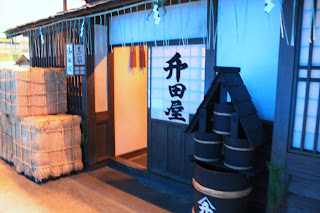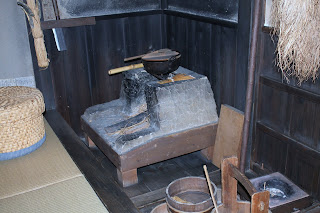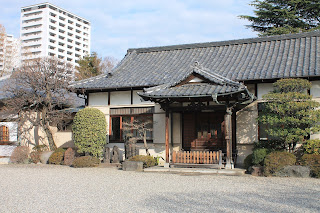Eine Reise in die Vergangenheit. Nach Fukagawa am Sumida Fluß, als hier alles noch klein und übersichtlich war. Obwohl, so sehr übersichtlich war ein Wohnviertel zur Edozeit dann doch nicht, eher verwinkelt.
Hier im Museum, dessen Wahrzeichen, der große Feuerwachturm, bereits im Straßenbelag als Wegweiser dient, ist eine kleine Nachbarschaft nachgebaut, die anschaulich macht, wie am Ende der Tokagawa Ära gewohnt und gearbeitet wurde. Hier am Fluß lebten Fischer, Handwerker und wohlhabende Händler, aber es gibt auch das Haus eines Shamisen-Lehrers. Insgesamt wurden elf Gebäude nachgebaut und besagter Feuerwachturm. Da Feuer eine ständige Gefahr war, in der engen Nachbarschaft von Häusern, die aus Holz und Papier gebaut waren, waren die Feuertürme, die bis zu zehn Meter hoch waren, ständig besetzt.
Es gibt einen Gemüseladen und einen Reishändler, ein Färber hat seine Tücher zum Trocknen aufgespannt, gewaschene Kleidung hängt auf der Leine, Pardon auf den Trockenstangen. Es gibt einen portablen Imbissstand, der Reisgerichte feilbot, ein Bootshaus, dass eine Gastwirtschaft für Boots-und Schauerleute, sowie Passagiere beherbergte. Ein Boot hat grad am Ufer festgemacht und wird bestimmt bald beladen werden. Es gibt Einblick in die Ausstattung der Wohnhäuser, die oftmals auch Werkstatt, Geschäft oder Büro waren.
Alles darf angefasst werden, damit man es besser begreift. Wenn man die Häuser betreten will, zieht man vorher die Schuhe aus, schließlich ist hier Japan und wenn man fertig ist mit Spielen, räumt man bitte alles wieder zurück.
Eine kleine Sonderausstellung informiert über lokale historische Geistergestalten aus der Mythologie und wenn es damals schon Kino gegeben hätte, wären sicher ein paar gute Horrorfilme entstanden. So blieb es dann eher bei unbewegten Bildern, die in entsprechenden Geschäften vertrieben wurden (siehe auch http://fraumb-far-far-away.blogspot.de/2012/01/einmal-edo-und-zuruck-edo-there-and.html?m=0).
A journey backward. To Fukagawa at Sumida River, when everything was small and lucid. Although that lucid was a neighborhood in Edo time not really, it was more contorted.
Here at the museum, wich landmark, the big fire watch tower, already in the pavement is used as a signpost, is build a small part of a living area from the end of Tokugawa era, that shows, how people lived and worked here at this time. Here at the river lived fishermans, craftsman and merchands, but also a house of a Shamisen teacher is to be found. All in all eleven houses have been rebuild and the already mentioned fire tower. Fire was a constant danger in the narrow streets between houses made of wood and paper, so the towers, some of them about ten metres tall, were permanent manned.
There is a vegetable shop and a rice trader, a dyer tense his fabrics for drying, washed clothes at the clothing line, pardon stick, there is a portable foodstall, wich sold rice dishes, a boatshouse, wich housed an Inn for skipper, dockers and passengers. There is a boat tied at the bank waiting for load. One can get a look into the living houses wich often are also shoppe, workshop and office.
Everything can be touched to take it. One can enter the house, but shoes off, we are in Japan here and after playing with the items, please put them back.
A small special exibition informed the visitors about local historical ghosts and haunted persons, and if there were already Cinema, they would have made fine horror movies out of that. So there are only pictures wich were sold at special bookshops at that time ( see also http://fraumb-far-far-away.blogspot.de/2012/01/einmal-edo-und-zuruck-edo-there-and.html?m=0).
One can stay here a long time, day and night, it's about 45 minutes from dawn to dusk, and because it's winter the trees are without leaves and very less vegetable is growing in the front garden behind the houses between privy and bin. It will be different in spring and summer, but then will be much rain, that's why I won't stay that long, but have a look at Fukagawa today and the sunshine outside.


























































Keine Kommentare:
Kommentar veröffentlichen